|

Cody, Jan. 1, 1901. Photo by L. E. Webster (Lewis Elmo Webster).
Webster (1878-1963) was the son of William P. Webster, the first postmaster of Cody. The Websters arrived in the area
in 1893 initialling settling at Ishawooa in the Absarokas. The younger Webster was a "jack of all trades" and was not only a photographer, but acted with his father as
a guide, he worked as a surveyor's assistant and as a wolfer. He was an initial member of the Cody Coronet Band formed in 1902 and played alto Coronet. He was also a member of the
Woodmen of the World. About 1912, he moved to San Fernando, California.There, he worked as a photographer and surveyor. Later he owned
grocery store.
As a wolfer, he wrote to hunter-Trader-Trapper Magazine, October 1905, p. 61:
We have all the fur bearing
animals found anywhere In the northwest, such as beaver, mink, marten, fisher, otter, muskrat, weasel, coyote, wolf, fox and skunk: also mountain lions, all of which I have caught in the state, but I keep most of my furs for around my den.
There is no bounty paid for anything here but the coyote, which is $2.50, and wolf $8.00. and 25 to 50 cents private stockman's bounty. As for the care of the hides after caught. I case the hides of the otter, mink, marten, muskrat and weasel with two boards and a wedge. Take two 3-lnch boards for the larger hides and others according to the size of the hide, then round the outside corner on one end to fit the head and nose, then take a long wedge and wedge them apart as tight as you wish them stretched.
The beaver and badger I stretch as round as possible, ripping them open on the belly and inside of legs. The hides of the coyote, wolf and bear are stretched as near the shape of the animal as possible by ripping down the belly and out on the legs.
I tan my own hides with a dry tan. By using a fresh hide it only takes about a week in the tan. I also tan deer, elk and antelope hides for buckskin to be used in making gloves and clothing.
L. E. Webster, Cody.
In addition to the bounty, Webster would receive anything paid for the hides or pelts.At Irma Flat, Felix Alston's General Store advertised the "highest market price paid for hides and pelts." See
Wyoming Dispatch, December 20, 1902, p. 4. For general discussion of wolfers, see
wolfers
Webster documented with his photographs some of the early businesses in Cody. By 1903, there were some ten saloons in the town. Three of the more prominent
were Richard A. Roth's Saloon, Ben Primm's "Cody Exchange" and Fred Primm's Cody Hotel Saloon.
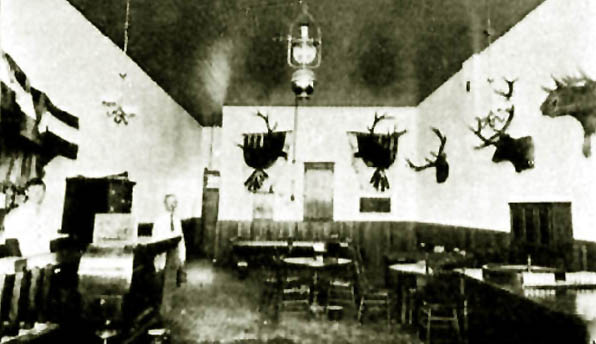
Interior Richard A. Roth's Saloon, 1903.
Roth came to Cody in 1902. He was a charter member and secretary of the local aerie of the Fraternal Order of Eagles. The saloon
depicted he constructed in 1903 for $3,000. In 1905 Roth sold the saloon apparently receiving a substantial sum. From
there the mystery begins. On November 20 the Omaha Daily Bee reported:
CODY, Wyo., Nov. 19. As they were
about to board a train for Denver, with
tickets furnished by telegraph from that
place. Hilda Ahlstrom and Mary Kramer,
who have been in Cody for several years.
were detained by deputy sheriff Henry
Hammit and held to await the Investigation
as to the death of R. A. Roth, a
prominent business man of this place, who
died under most mysterious circumstances.
During the afternoon and evening until
midnight. Roth and the two women had
been driving together. Later Roth was
found in a demented condition. He died,
as the physicians state, with every symptom
of arsenical poisoning, and the local
order of Eagles, to which Roth belonged,
has sent the stomach to Denver for anlysis.
Roth recently sold his saloon business
here and was known to have a large
sum of money on him. Only $50 was found
by the coroner.
A later report indicated that physicians were split as to cause of death, two believing
arsenical poisoning and two from Bright's disease. From there the mystery remains,
what happened to Roth's money and what happened to Ahlstrom and Kramer?
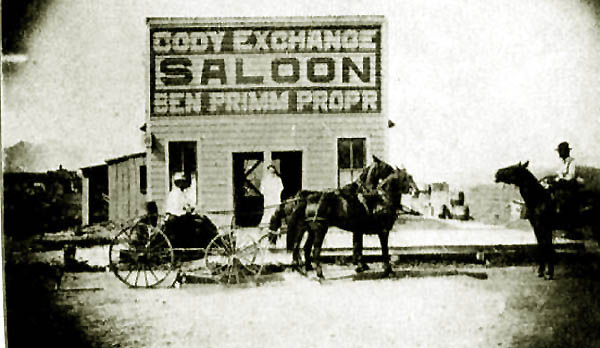
Ben Primm's Cody Exchange Saloon, 1903.
Both Primm's and Roth's saloon had gambling and both had their gambling banks robbed by masked
robbers. At Primm's about 14 men were engaged in a "social chat" (See Dispatch, Sec. 27, 1902, p. 1) when the roulette bank was robbed. At
Roth's the Faro table was robbed. In neither instance, however,were the patrons robbed. The robbers were never
caught.
The Sheridan Post, Industrial Edition [an advertising supplement], Sept 30, 1903, in a blub
featuring Primm's saloon, noted that Primm came Wyoming at age 17 from Illinois in 1886, "he
liked the free and easy ways and bright sunshine of the West, and has remaned ever since."
In reality it was probably not the bright sunshine which kept Primm in Wyoming. For at least a part of the time
he may have been suffering from prison palor as a guest of the State. In 1895, he was convicted in Johnson County of
having enticed an old man, sixty years old, into a house of ill repute, getting him drunk, and robbing him in th alley behind the
Buffalo Bulletin. Following release from prison he was restored to his civil rights.
On February 29, 1904, the Laramie Republican reported that Primm had died of a sudden "heart failure." A week later on March 8, the Sheridan Post revealed that the sudden heart failure
was as a result of a fight with Deputy Game Warden Carl Hammitt. The Cheyenne Wyoming Tribune, however, referred to to his death as under
"Suspicious circumstances after a beating received from an officer." See the
Tribune Feb 27, 1904, p. 3. Shortly before his death, Primm had married
the daughter of the Reverend Sam Small, a temperance advocate. The Thermopolis Record referred to Small as the
"pyrotechnic evangelist." Primm's estate amounted to approximately
$1500. Earlier, Mrs. Primm had engaged in a "Common Law" marriage with Dr. Julius Schuelke and applied to the Courts for
a widow's share of his estate. She lost. See Weidenhoft v. Primm, 10 Wyo 342, 94 Pac. 451 (1908).Wyoming does not recognize
Common Law marriages. Within a short time, Mrs. Primm remarried several times to such an extent that the Record, March 14, 1908, p. 1, referred to her as
"Mrs Lois Small-Schulke [sic]-Primm-Jolly." Dr. Schuelk died on the stage to Casper apparently from a morphine overdose. The Lander Clipper, August 7, 1903, p. 1, referred to it as
suicide.
The Cody Hotel on Sheridan Ave. adjacent to where the Silver Dollar Bar is now (2017) is located,
was established in 1897 and was operated by a variety of owners until taken oven by
Fred Primm and his wife. Mrs. Fred (Katrina) Primm operated the hotel and Fred the saloon.
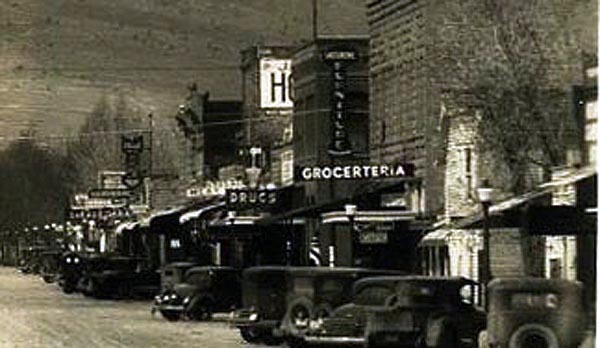
North side of Sheridan Ave., showing Cody Hotel, approx. 1935.
The Grocerteria was operated by Gustav Aldolph "Gus" Ebert (1887-1982). The hotel was primarily a boarding house with a bar and
dining room. In the early years, a meal would cost thirty-five cents. The hotel builind was torn down in the
1960's. A trace of the hotel, however, remained. A small one-story extension was on the west side of the
hotel and abutted the adjacent building housing the grocerteria. The extension originally house a bar and the
lobby.
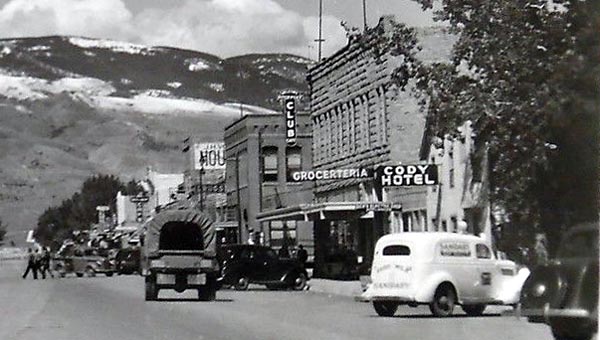
Cody Hotel between the white sedan delivery and the Grocerteria, approx. 1938.
For some years following the hotel's demise, a "ghost" outline of the roof of the extension
could be seen on the east end of the Silver Dollar Bar.
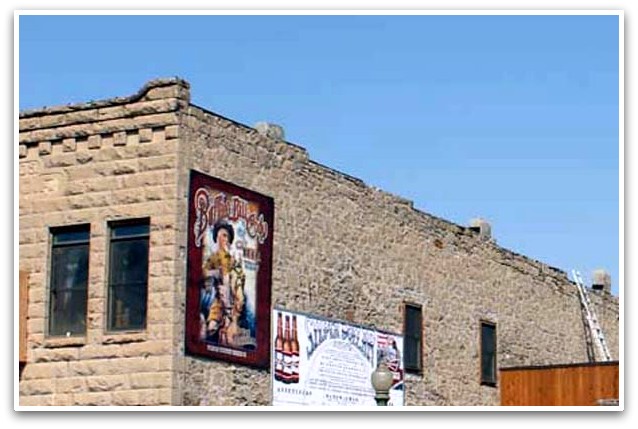
"Ghost" outline of roof extension of Cody Hotel on end wall of Silver Dollar Bar, Sheridan Ave.
Cody.
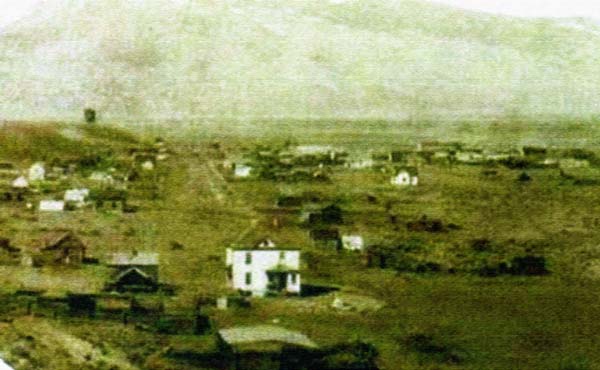
Cody, looking south approx. 1904.
Dating of the above photo is based on the
dates of indivual buildings and the water tank. In the above image, the newly constructed water tank is visible on the hill. Whisps of smoke from an arriving train on the
extreme right, drift across the background. Further in the background the Absarokas are obscured by a haze.
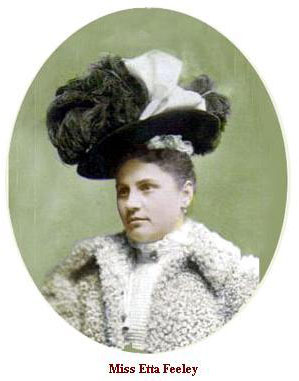
On the edge of town near the end of Bleistein Avenue was an area known as the "Scarlet Way." The center of the Scarlet Way was a big white house on Lots 8 and 9 Block 1 occupied by Etta Feeley (1871-1960). Miss Etta's house
was one in which in which lonely sheepherders, cowboys and boys workin on Col. Cody's
irrigation project could take their ease. Immediately to the east of Miss Etta's establishment on Lots 12 and 13 Block 1 was a one-story house sometimes referred to as the
"green house" operated
by Miss Ollie Archer. About a block away on Salsbury was another house operated by Miss Cassie Waters. Miss Etta's establishment was operated from 1902 to 1910.
"Feeley" was not her real name of course. It was, however,
her professional name which she used on occupational licenses and in court. Her real name changed several times as she went through several marriages. Miss Cassie also
regularly changed her name and was also known as Cassie La Fay and Cassie McGhan. The three facilities were also licensed as saloons but in other documents
referred to as "female boarding houses".
Miss Etta had previously operated a similar
establishment in Montana. There, it was apparently a high class facility. In 1895 she was advertising in the Anaconda Standard that she needed a
piano player. In 1902 in Cody, she applied for and paid for an occupational license as a "saloon." Of course, there were other saloons. The cost of the
occupational license was $300.00. Although licensed as a
saloon the facility was, as described by the Dispatch, Feb. 7, 1902, a "house of ill shape [sic]." It may, however,
been a typographical error, in that the next month the paper referred to it as being "occupied for purposes of ill fame."
See Dispatch, March 14, 1902. Almost immediately Miss Etta ran into legal problems. She was sued by Maggie Jess for $200 for alleged
unlawful detention of premises. Miss Maggie operated a similar type of establishment on Laurel Avenue in Buffalo. Miss Maggie purchased the property
leased by Miss Etta, but the purchase did not eliminate Miss Etta's leasehold estate and ultimately Miss Maggie's lawsuit was dismissed.
Jake Schwoob sued her on an account. Criminal proceedings were brought in the name of the
State charging Miss Etta with criminal detainer, criminal tresspass, and selling liquor without a license in Cody, and selling liquor without a license in
Garland. All of the charges and suits were dismissed. See Dispatch, March 14, 1902 and April 17, 1902.
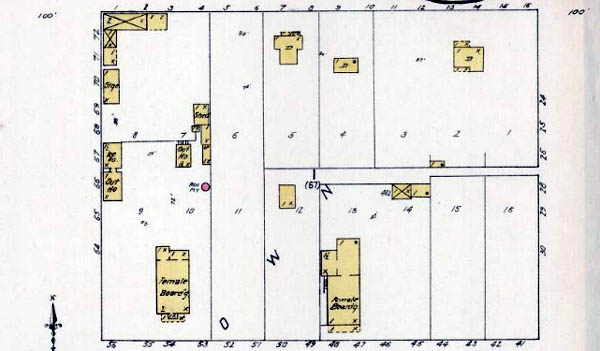 Sanborn May Block 1, 1912 showing location of
Miss Etta's and Miss Ollie's facilities. Sanborn May Block 1, 1912 showing location of
Miss Etta's and Miss Ollie's facilities.
There was a certain degree of revelry [and rivalry] going on in the female boarding houses. Miss Ollie's seems to have had a more sporting air. One young cowboy
came to the bright lights of Cody and met two men
who he knew by name. They took him to several saloons. Sir Harry Lauder, a Scotish music call singer, used to sing a song of the
farmer who used to hang his trousers on the back of the bedroom door and in the morning when he awoke was stony broke.
Our young cowboy when he awoke in a strange bed with no idea of how he got there, found he had been relieved
of $110.00. He thought that the women had taken his money. He shot the place up and his money was returned. In the process of being taken before the
judge he was wounded in the leg. He was fined $5.00 and costs were assessed in the amount of
$3.00 together with a lecture from the judge.
Generally, houses of ill repute were illegal in Wyoming. See Compiled General Statutes, 1910, Section 5905. But violation of the statute
was difficult to prove. See. Konepisos vs. State, 26 Wyo. 350, 185 Pac. 354, (1919). A disincentive to enforcement of the
law was the revenue devrived by the local community. By 1910, the license fee to Park County was $1,000 equal with inflation as of June 2014 to some $24,075.
Additionally, Miss Etta had to pay various fines levied by the local court. Allegedly in one month Miss Etta paid
$300 in fines. Miss Etta apparently took the hint and opened a facility in Sheridan. Miss Etta's difficulties with Cody officials may have been motivated by the
construction of a nearby new school. A block away from Miss Etta's White House was another factility on Salsbury owned by Miss Cassie Waters which also had to move.
Miss Cassie moved further away from the school.
As to Miss Etta's Sheridan establishment, the Sheridan Post, Nov. 6, 1911, reported that one of her girls,
Veta O. "Rabbit" Blines, committed suicide by drinking carbolic acid. In 1915, Miss Etta was charged wtih selling liquor to an American Indian. See Sheridan Post, March 26, 1915.
She defended on the basis that she did not know the individual was an Indian, she thought him to be Mexican. The noted that the individual spoke
English better than most whites. The trial court held that it was irrelevnt whether Miss Etta knew the indivdual was an Indian. Serving the
alcohol to an Indian whether she knew the individual was an Indian or not was illegal. Miss Etta appealed her conviction to the
United State Court of Appeals in Denver. The appeal was denied. See Feeley vs. United States, 236 Fed. 903 (8th Cir. 1916).
In the meantime in Buffalo, Miss Maggie had her own difficulties. In 1895, she faced a foreclosure sale. In 1911, the School Board requested that
the Town close her down. Apparently no action was taken. She was still open as late as 1918.
Ultimately Miss Maggie moved to Pensylvania.
Miss Cassie was involved in the fall from grace of Cody's one-time popular physician Dr. William Sabin Bennett. Dr. Bennett came to Cody in 1904 from Meeteetse.
In Cody, he established a medical practice and owned a drugstore and
jewelry store. He was on the official welcoming party for Prince Albert of Monaco. He was able to send his three boys to Ivy League colleges, Yale, Cornell, and Colgate. Following college,
William, Jr. became a lawyer with the United States Attorney's office in Denver.
In Cody it was life in the fast lane, not just in his high-powered motor cars in which he had numerous single car accidents as a result of driving too
fast on the narrow bad roads of the time, but in his business and personal life. He served at different times on the school board, as Mayor of Cody, legislator and was appointed
County Health Officer. He was active in the Masonic Order, He invested in mining projects in Nevada and New Mexico. It was like an individual the writer knew quite some years ago who was in
the timber and sawmill industry, was president of a
bank, chairman of a local govenmental agency and was on the board of directors of the local electric co-op. He was leveraged to the hilt. At lunch when he picked up his sandwich,
it was shaking visibly. In landing his airplane one day, he forgot to lower the
wheels. He survived, but it became obvious that keeping all the balls in the air was getting difficult. One day, he dropped a ball. They all fell,
the individual moved to Brazil to work for someone who formerly had been a customer.
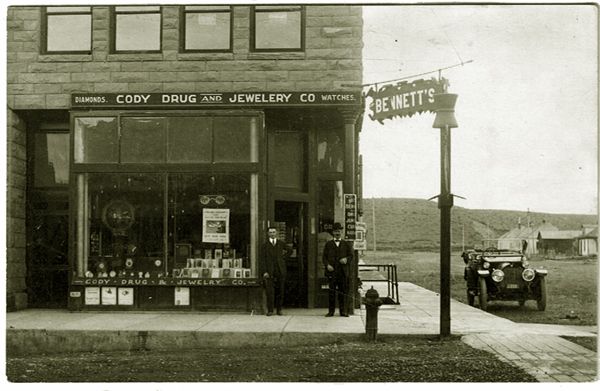 Dr. Bennett's Jewelry store and drug store. Dr. Bennett on right. Man on the left
believed to be Jay Powers, the pharmacist and store manager. Powers was a relative of Mrs. Bennett. He left in 1916 to go to medical school. The car on the right is
is Dr. Bennett's Hudson phaeton. Dr. Bennett's Jewelry store and drug store. Dr. Bennett on right. Man on the left
believed to be Jay Powers, the pharmacist and store manager. Powers was a relative of Mrs. Bennett. He left in 1916 to go to medical school. The car on the right is
is Dr. Bennett's Hudson phaeton.
Maybe to relieve the stress, Dr. Bennett became besmitten with Miss Cassie. It would not decorious to be seen entering
Miss Cassie's house. Instead there were dalliances out in the country in Miss Cassie's tepee. In a small town
everyone recognizes everyone else's car. And certainly no one would overlook Dr. Bennett's Hudson Super Six Speedser Phaeton. It replaced an earlier
Hudson. The Hudson Motor Car Company advertised that the Super Six was capable of 102 1/2 miles per hour. Dr. Bennett got the car stuck
during one tete a tete off the old South Fork Road.
Rumors abounded. A final straw may have been when he purchased identical dresses for
his wife and for Miss Cassie -- and the two met at the post office each wearing the same dress.
Dr. Bennett moved from Cody to Greybull and attepted to re-establish his medical practice there. Four months later
he was thinking of moving his practice to Montana. He and a Mrs. St. Clair, were caught registered under ficticous names in a hotel
in Lodge Grass, Montana. In Sheridan, the two were caught at 3:45 a.m. in the same hotel room in
the Sheridan Inn, she in a negligee. Mrs. St. Clair attempted to depart the room by way of a window. Dr. Bennett claimed nothing untoward happened.
He said had become ill and that he had called
Mrs. St. Clair to minister to him.
The Cody Club passed a resolution directed to Governor Carey for whom one of Dr. Bennett's sons worked as an aide. The resolution, which minced no words, requested that the
Governor remove Dr. Webster as health officer for Park County. The incident at the Sheridan Inn
came to the attention of the United States Attorney in Denver. Dr. Bennett was indicted for violation of the Mann Act, which made it a felony to transport
a woman across a state line for an "immoral purpose.". At the first trial in
Cheyenne there was a "hung jury." The case was set for a second trial eventually set for 1924. In March 1924 before his case would come up for trial, Dr. Bennett traveled to Ely, Nevada, where he had mining interests.
The mining interests were not going well. Mining equipment had not been paid for. He was sued by the equipment manufacturer. See Richmond Machinery Co. v.
Benett, 229 Pac 1099 (Nev. 1925). Ten days after his arrival in Nevada, Dr. Bennett was dead, dead from, according to the death
certificate, from "alcoholism (chronic)" with a contributary cause of "moonshine." Dr. Bennett's son, William, traveled to Ely to claim the body which was interred in
Ely.
Col. Cody heavily invested in the area. In addition to the Irma hotel which opened on November 18, 1902 and named after his daughter, pictured below,
his enterprises included the Cody
Trading Company, a livery stable and the Cody Enterprise. In addition, near Meeteetse he
purchased the Carter Ranch on the South Fork of the
Stinking Water (now the South Fork of the Shoshone) which he named the T E.
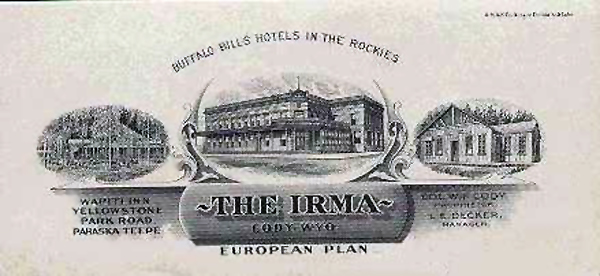
Irma Letterhead, undated.
As indicated by the letterhead, Cody's brother-in-law, Louis Decker, was general
manager of the hotel which opened in in 1902.
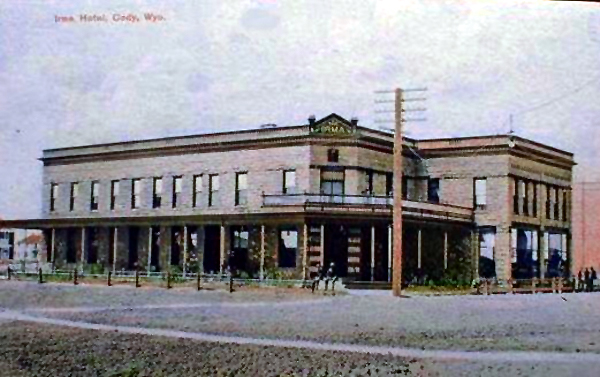
Irma Hotel, approx. 1910.
Lower Left, Irma Hotel, 1908, photo by F. J. Hiscock
In 1901, the town was incorporated. Initial gowth was slow. Earlier in 1897 upon the formation of Bighorn County,
the developers believed that it was necessary for the town to become the
County Seat. At the time there were only a few buildings in town.
Cody had competed with Basin, and Otto to become the county seat. It was no contest. As expressed by Robert F. Bonner in his
"William F. Cody's Wyoming Empire," University of Oklahoma Press, 2016: "It is hard to see how
anyone could have thought that a little town a few months old with half a dozen buildings,
no real post office and no working water supply had a chance * * *."
Indeed, the lack of a working water supply was a problem. The town was perched on a bench above
the Stinking Water. There was no water supply system until 1904 when the town let a contract for construction of a
water system to replace the "present primitive, expensive and inconvenient method of being supplied with water." See Enterprise, Feb. 4, 1904, p 1.
And what was the inconvenient system? The water was brought up from the river in barrels by the Hutsonpiller & Darrah Livery and Feed Barn.
According to the Dispatch, Dec. 20, 1902, p. 1,it took "six water wagons constantly on the go, to supply Cody with water."
The editor of the Dispatch six months earlier on May 16, page 4 rejoiced when the telephones came in:
Cody is now connected by telepone, nearly all the business houses have a phone and we find it very concenint. We can now
sit in our office and call up the water man and have him deliver us a barrel of water, or the grocery man and ask him to deliever a box of
matches, and so on, and the best of all,we can call up our frient Kissick over at the depot and ask him about ten times if the train is on time.
Still better, when we want to borrow money from the bank, and feel sure he will refuse us, it will not be so
hard to ask him when we can do so by phone and not have to look him in the face.
yest; very convenient this phone arrangement, wouldn't be without one for fout times the price."
On occasion Elmo Webster would fill in for the telephone girl.
Professor Larson, on the other hand, believed that the competition by
Cody for the County Seat was simply to take votes away from Otto. See Larson, 2nd Ed. p 304l
County Seat. But Cody did not give up. In 1910, Park County was formed and Cody became the county seat.

Col. Cody with first county officers, January 1911.
Left to Right: Left to Right: Col. W. F. Cody; Henry Fulkerson, Assessor; Andy Martin, Commissioner; Henry Dahlem, Sheriff; Walter Kepford, Commissioner: Jessie Hitchcock, Superintendent of Schools: W. H. Fouse, Commissioner; Gus Holm, Treasurer; E. M. Cowell, DeputyClerk; Fred Barrett, Clerk.
Much to the consternation of the Enterprise, expressed across three columns, among the first things the new Commission did was to designate
Wyoming Northern Herald and Irrigation Era as the official paper of the County. The Herald, according to the Enterprise, January 7, 1911,
"is not now and never was a legal publication." Additionally, the County leased the County Building for two years for $40.00 a month.
By 1905 in addition to Col. Cody's enterprises, the town consisted of several stores,
a competing livery stable, a competing newspaper, the "Cody Hotel," a lumber yard, and a half dozen or so
saloons and gambling dens. The editor of the Enterprise, Hook accidently got himself into hot water with the saloons when,
without his knowledge, a friend inserted an editorial in the paper attacking the saloons and gambling. A
fair amount of the advertising was from saloons. The competing livery, Hutsonpillen & Darrah, advertised, "The Automobile is expensive and
very dangerous unless an expert guides it and handles the lever." The livery noted, however,
"The Horse is the sure and reliable animal to convey one from place to place in this mountainous country."
In addition to the saloons there were several
parlors
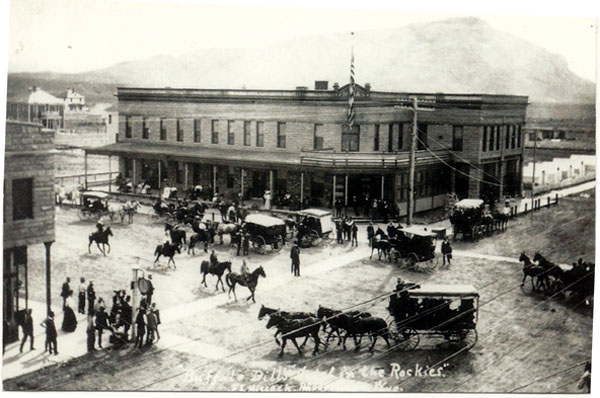
Grand Opening, Irma Hotel, Photo by F. J. Hiscock.
The Irma was constructed by Cody in 1902 and
was designed by famed Nebraska architect Alfred Wilderman Woods. Although intended as a
luxury hotel, some guests were less than impressed. In 1916, Horace M. Albright (1890-1987) escorted
National Park System Director Stephen Tyng Mather (1867-1930) on a tour to Yellowstone. On the
first night of the tour, the Mather party stayed at the Irma. In his Creating the National Park Service:
the Missing Years, Horace M. Albright and Marian Albright Schenck, University of Oklahoma Press,
Norman, 1999, Albright gave an account of the stay. The dinner was a disaster, with bad food and terrible service.
Albright at the request of Director Mather checked the kitchen. According to Albright, "It was about the dirtiest, most
unsanitary place I had ever seen."
The rest of the evening turned out to be equally bad. First of all, Mrs.
Mather insisted on sitting up all night in the lobby after she discovered
"things crawling in the bed." Mather ordered a pillow and blankets for her,
saw to her comfort, and then disappeared back to the lice, bedbugs, or whatever.
He didn't last long there because when he opened the door to his room he found two
men asleep in his bed. Downstairs at the desk he demanded another room.
"there is no other room," said the clerk. "You'll just have to make your bedfellows move over."
Albright had a similar experience being awakened by a strang man crawling into his bed. As he lay awake listening to
the snores of his bedmate, he became aware of the "various bugs that had missed Mrs. Mather," and
thus moved to the floor.
Others complained about conditions in the hotel. When the hotel was sold to H. T. Newell in 1925, the Enterprise reported:
We are glad to learn that the hotel is to be remodeled with hot and cold running water in each room and
installation of baths. Party headed by the astude editor of the [Inland Oil} Index stopped at the Irma two years ago and they
put us in the annex which at one time was used by Buffalo Bill as a stable. There were no assets in the rooms
save the old fashioned water bowl and pitcher, a lop bucket and some decrepit furniture. Posted in conspicuous places were signs warning the
guests notto use the loop buckets for any other purpose than waste water under penalty of
having $2 added to the bill of each occupant. We are stong for the new management, hot and cold water and bath rooms.Cody Enterprise, April 1, 1925, p. 2
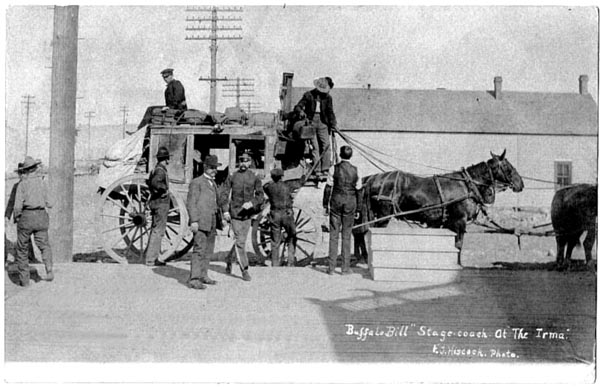
Stage at entrance to Irma Hotel, 1906. Note shadow of upper porch
railing on the sidewalk.
porch
The Cody Meeteetse Thermopolis Stage Line offered stage service south out of Cody.
Additionally, there was weekly stage service to Painter in the Sunlight Basin to the northeast of Cody. By 1908 it was
proposed to use autostages for the trip to Meeteetse. In 1908, also, the Big Horn Development company purchased six seven-passenger
Rambler automobiles to provide transportation to Basin. In 1916, autostages were instituted to Yellowstone.
Much of the Town of Cody was constructed
by a friend of Cody from Buffalo, N. Y, Henry Montgomery Gerrans (1853-1939). Gerrans was
a director of the 1901 Pan American Exposition in Buffalo at which the
Wild West Show performed. The Buffalo, N. Y., influence on the Town of Cody is
perhaps also reflected in the name of three streets, Gerrans Ave., Bleistein Ave. and Rumsey Ave. George
Bleistein was also a director of the Exposition. At one time Miss Etta's establishment was located on
Bleinstein Avenue near where the Eastside School is now located. The Rumsey family farm in Buffalo was
used as a site for the Exposition. Beck, Alger, George Bleistein, H. M. Gerrans, Bronson Rumsey, II, are all regarded as
the co-founders of the Town. Also moving to Cody from Buffalo, New York was Jacob M. "Jake" Schwoob
(1874-1932) who became a partner and manager of the
Cody Trading Company on the corner of 13th and Sheridan Ave.
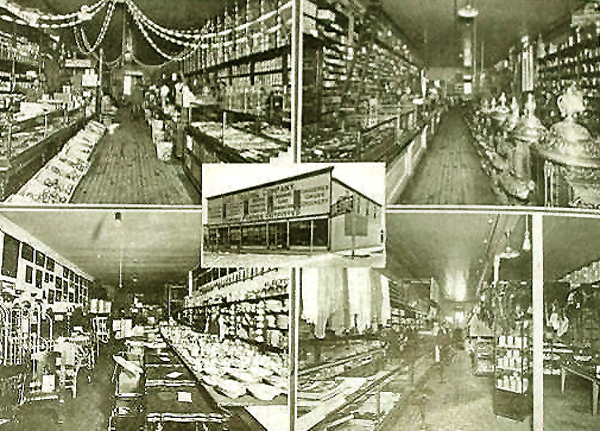
Cody Trading Company, approx. 1911. Photo by A. G. Lucier
The building depicted burned in 1913 and was replaced by a new building on the same site. Schwoob became the first
treasuer of the Town of Cody. Two years later he was elected mayor. In 1905 he was elected to the State Senate and became president of
the Senate in 1911. When Wyoming introduced license plates in 1913, he was given license plate No. 1.
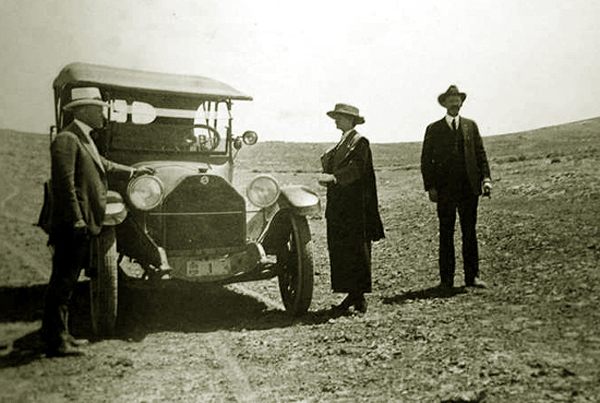
Jake Schwoob with hand on headlamp, license plate No. 1, approx. 1913
Next Page: Cody continued.
|